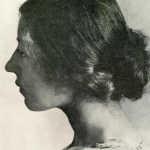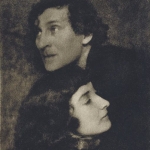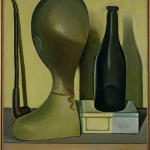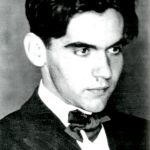FERNAND KHNOPFF ~ I LOCK MY DOOR…



MARIA YAKUNCHIKOVA (1870-1902) WOMEN WITH A PASSION FOR ART The first female artist I want to introduce in the series

MARC AND BELLA CHAGALL ~ A COLORFUL LOVE “In our life there is a single color, as on an artist’s

WILLIAM BOUGUEREAU AND HIS PASSION FOR PAINTING “Each day I go to my studio full of joy; in the evening

“From the moment of my birth, the angels of anxiety, worry, and death stood at my side, followed me out when I played, followed me in the sun of springtime and in the glories of summer. They stood at my side in the evening when I closed my eyes, and intimidated me with death, hell, and eternal damnation. And I would often wake up at night and stare widely into the room: Am I in Hell?”
Edvard Munch

“I am a writer and I want to write.” ― Jane Bowles Fear and Hope “Like most people, you

MARIA YAKUNCHIKOVA (1870-1902) WOMEN WITH A PASSION FOR ART The first female artist I want to introduce in the series

MARC AND BELLA CHAGALL ~ A COLORFUL LOVE “In our life there is a single color, as on an artist’s


MARIA YAKUNCHIKOVA (1870-1902) WOMEN WITH A PASSION FOR ART The first female artist I want to introduce in the series

MARC AND BELLA CHAGALL ~ A COLORFUL LOVE “In our life there is a single color, as on an artist’s

WILLIAM BOUGUEREAU AND HIS PASSION FOR PAINTING “Each day I go to my studio full of joy; in the evening

Poema del Atlantico/La Noche (1917-1918 Poem of the Atlantic/Night by Nestor Martin- Fernandez de la Torre
This painting is part of the series called Poem of the Atlantic, painting of the Atlantic Ocean in various times of the day and night.
Nestor Martin (1887-1938) is the only Canaries painter, who being part of the symbolist and modernist European currents, left a major collection of work, one that is an essential part of these movements.
The first thing I did when I came to Gran Canaria was visiting Las Palmas and the wonderful Museo Nestor where one can admire Nestor’s collection of paintings. I was impressed and I still am!!! What a great painter coming from Gran Canaria…

MARIA YAKUNCHIKOVA (1870-1902) WOMEN WITH A PASSION FOR ART The first female artist I want to introduce in the series

MARC AND BELLA CHAGALL ~ A COLORFUL LOVE “In our life there is a single color, as on an artist’s

WILLIAM BOUGUEREAU AND HIS PASSION FOR PAINTING “Each day I go to my studio full of joy; in the evening


MARIA YAKUNCHIKOVA (1870-1902) WOMEN WITH A PASSION FOR ART The first female artist I want to introduce in the series

MARC AND BELLA CHAGALL ~ A COLORFUL LOVE “In our life there is a single color, as on an artist’s

THE SURREALITY/REALITY OF GIORGIO MORANDI. Giorgio Morandi (1890 -1964) was an Italian painter and printmaker. “There is nothing more surreal,

Witches’ Sabbath is a 1798 oil on canvas by the Spanish artist Francisco Goya . Goya used the imagery of covens of witches in a number of works, most notably in one of his Black Paintings, Witches Sabbath or The Great He-Goat(1821–1823) which contains similar sharp political and social overtones. At the time, a bitter struggle raged in Spain between liberals and those in favour of a church and a royalist-lead state
Witches’ Sabbath shows the devil in the form of a garlanded goat, surrounded by a coven of disfigured, young and aging witches in a moonlit barren landscape. The goat possesses large horns and is crowned by a wreath of oak leaves. An old witch holds an emaciated infant in her hands. The devil seems to be acting as priest at an initiation ceremony for the child, though popular superstition at the time believed the devil often fed on children and human foetuses. The skeletons of two infants can be seen; one discarded to the left, the other held by a crone in the centre foreground.
The English word “sabbat” came indirectly from Hebrew (שַׁבָּת). In Hebrew it means “to cease” or “to rest”. In Judaism Shabbath is the rest day celebrated on Saturday. In connection with the Medieval popularity of the belief that Jews worship the Devil, satanic gatherings of witches were called “sabbats” or synagogues. The latter is a Jewish places of worship, much like a church. Alternately, some Christians were accused of Judaizing. Christian Sabbathkeepers, who never accepted Emperor Constantine’s edict in 321 A.D., the first enforcing Christian worship on Sunday rather than on Sabbath, were demonized and accused of witchcraft; hence, the accusatory nomenclature, “witches’ sabbath.”
Source Wikipedia

MARIA YAKUNCHIKOVA (1870-1902) WOMEN WITH A PASSION FOR ART The first female artist I want to introduce in the series

Federico Garcia Lorca “Let there be a landscape of open eyes and bitter wounds on fire. No one is sleeping

MARC AND BELLA CHAGALL ~ A COLORFUL LOVE “In our life there is a single color, as on an artist’s

Witches’ Sabbath is a 1798 oil on canvas by the Spanish artist Francisco Goya . Goya used the imagery of covens of witches in a number of works, most notably in one of his Black Paintings, Witches Sabbath or The Great He-Goat(1821–1823) which contains similar sharp political and social overtones. At the time, a bitter struggle raged in Spain between liberals and those in favour of a church and a royalist-lead state
Witches’ Sabbath shows the devil in the form of a garlanded goat, surrounded by a coven of disfigured, young and aging witches in a moonlit barren landscape. The goat possesses large horns and is crowned by a wreath of oak leaves. An old witch holds an emaciated infant in her hands. The devil seems to be acting as priest at an initiation ceremony for the child, though popular superstition at the time believed the devil often fed on children and human foetuses. The skeletons of two infants can be seen; one discarded to the left, the other held by a crone in the centre foreground.
The English word “sabbat” came indirectly from Hebrew (שַׁבָּת). In Hebrew it means “to cease” or “to rest”. In Judaism Shabbath is the rest day celebrated on Saturday. In connection with the Medieval popularity of the belief that Jews worship the Devil, satanic gatherings of witches were called “sabbats” or synagogues. The latter is a Jewish places of worship, much like a church. Alternately, some Christians were accused of Judaizing. Christian Sabbathkeepers, who never accepted Emperor Constantine’s edict in 321 A.D., the first enforcing Christian worship on Sunday rather than on Sabbath, were demonized and accused of witchcraft; hence, the accusatory nomenclature, “witches’ sabbath.”
Source Wikipedia

MARIA YAKUNCHIKOVA (1870-1902) WOMEN WITH A PASSION FOR ART The first female artist I want to introduce in the series

Federico Garcia Lorca “Let there be a landscape of open eyes and bitter wounds on fire. No one is sleeping

MARC AND BELLA CHAGALL ~ A COLORFUL LOVE “In our life there is a single color, as on an artist’s

The fine art of painting, which is the bastard of alchemy, always has been always will be, a game. The rules of the game are quite simple: in a given arena, on as many psychic fronts as the talent allows, one must visually describe, the centre of the meaning of existence.
Brett Whiteley (Australian artist, 1939-1992)

MARIA YAKUNCHIKOVA (1870-1902) WOMEN WITH A PASSION FOR ART The first female artist I want to introduce in the series

MARC AND BELLA CHAGALL ~ A COLORFUL LOVE “In our life there is a single color, as on an artist’s

THE SURREALITY/REALITY OF GIORGIO MORANDI. Giorgio Morandi (1890 -1964) was an Italian painter and printmaker. “There is nothing more surreal,


MARIA YAKUNCHIKOVA (1870-1902) WOMEN WITH A PASSION FOR ART The first female artist I want to introduce in the series

MARC AND BELLA CHAGALL ~ A COLORFUL LOVE “In our life there is a single color, as on an artist’s

THE SURREALITY/REALITY OF GIORGIO MORANDI. Giorgio Morandi (1890 -1964) was an Italian painter and printmaker. “There is nothing more surreal,

“A painted landscape is always more beautiful than a real one, because there’s more there. Everything is more sensual, and one takes refuge in its beauty. And man needs spiritual expression and nourishing. It’s why even in the prehistoric era, people would scrawl pictures of bison on the walls of caves. Man needs music, literature, and painting-all those oases of perfection that make up art-to compensate for the rudeness and materialism of life.”
FERNANDO BOTERO

“I am a writer and I want to write.” ― Jane Bowles Fear and Hope “Like most people, you

MARIA YAKUNCHIKOVA (1870-1902) WOMEN WITH A PASSION FOR ART The first female artist I want to introduce in the series

MARC AND BELLA CHAGALL ~ A COLORFUL LOVE “In our life there is a single color, as on an artist’s